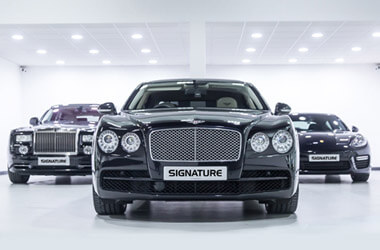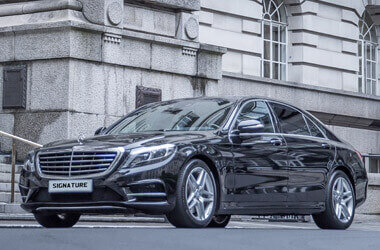Jaguar Car Hire
If you are looking for a Jaguar car hire experience, then Signature’s fleet of jaguar self-drive cars will offer you a luxurious way to experience the best of British engineering. As one of the most iconic car marques in the world, each Jaguar car rental model is elegant in design and offers prestige car hire drivers and passengers a breath taking car rental experience in the UK.
All our Jaguar car rental vehicles are bought new and come packed full of the latest technological features and high specifications to ensure you will be delighted with your self-drive car hire experience. Jaguar rental UK cars are imposing at the same time as sophisticated, extending to you exhilarating journeys in the UK when rented from Signature Car Hire on a self-drive hire basis.
To see which Jaguar car rental option suits your needs, simply click on the model above for prices and further information. If you need a Jaguar wedding car hire or Jaguar chauffeur car, then give Signature a call. Our experienced customer care advisors are available on 0207 118 2244 to talk you through all the benefits of our Jaguar hire models on fleet in our London showroom.
With Signature you can get your Jaguar car hire London experience organised with ease.
Jaguar is a British luxury vehicle brand with its headquarters in Whitley, Coventry, England. Jaguar engineers and designers create cars that offer responsive performance cars that gets drivers’ pulses racing. You can expect to experience cars that offer dramatic design that stirs your emotions each time you hire one.
Jaguar has a prestigious tradition of producing beautiful, fast saloon cars. This passion for excellence is combined with their ethos to go to extraordinary lengths to deliver the world's safest, most reliable and most dependable luxury performance saloons, sports cars and SUVs.
Jaguar characteristics and design are instantly recognisable throughout their fleet. If you rent any model from our self-drive hire rental fleet of Jaguars, you can expect an unmistakable simplicity of line that runs through all their models. Jaguar cars are athletic and authoritative; sleek and enticing; confident and instinctive.
The first Jaguar car on the market was the 1935 SS Jaguar 2.5l Saloon. It was produced under the Swallow Sidecar name, which is how the company was first set by William Lyons and William Walmsley in 1922.
During the pre-war-era, the 2.5l Saloon was known for being one of the most distinctive and beautiful cars, known for its sleek, low-slung design. The company decided that this car’s feline grace embodied qualities of power, elegance and agility, and so the marque Jaguar was born.
New design creations followed from William Lyons with introduction of the XK120 which went on to be one of Jaguars most iconic cars. This car was a sensation, with swooping fenders running the length of the car’s body, the XK120 was a dramatic masterpiece. This model introduced the vertically ribbed oval grille, which became a Jaguar hallmark over the next two decades.
The iconic C-type was certainly one of the most beautiful racing cars of its time. Aerodynamicist Malcolm Sayer was behind the C-type’s fluid shape and lightweight design. Perhaps the most memorable moment in the C-type’s history was at Le Mans. It won in 1951, but 1953 was without doubt its best performance.
The D-type, with its signature tail fin, was the first to use aircraft design techniques with the introduction of monocoque construction. Aerodynamicist Malcolm Sayer once again used advanced aerodynamic principles to make contours that were outstanding and lightweight. The fluid shape of the D-type was developed from many hours spent in the wind tunnel, complying to Sayer’s principle that form followed function. Distinctive features including the oval air intake, the sweeping bonnet, the half-faired rear wheels, the distinctive and stabilising tailfin all combined to make this model one of the most beautiful competition cars ever produced.
The Mark II followed having been inspired by the D-type. It featured a sub-frame mounted suspension and straight six engine in 2.4, 3.4 and 3.8 litres. The Mark II was light and airy and ahead of its time.
The Jaguar E-type that followed has since become one of the most-loved examples of British car design in history. The E-type that premiered at the 1961 Geneva Motor Show changed the performance car scene forever. The model featured a long and elegant bonnet combined with a sleek monocoque design. With its 3.8 litre straight six engine, its performance matched its appearance.
The Jaguar XJ6 was the last car designed by Sir William Lyons and held testimony to his bold design ideals. This model also inspired future Jaguar Director of Design, Ian Callum. The task of replacing the iconic E-type fell to Malcolm Sayer. His XJ-S was even more aerodynamic than its predecessor.
Entering a new era of safety regulations in 1975 meant Jaguar had to move away from the free and easy spirit of the 1960s E-type. But it still channelled luxury and embodied the bold Jaguar attitude. The XJ-S also debuted the third all-original Jaguar engine, with a new straight six 3.6 litre beneath the bonnet. The V12 engine added to the car’s spirit of luxury and showcased its sporting potential too.
As Jaguar entered the 90s, the XK8 took design inspiration from Jaguars past, blending past Jaguar models into a sleek shape that met all the modern requirements of space, safety and luxury. The XK8 went on to become the fastest selling sports car in Jaguar’s history at the time.
Jaguar design was reinvigorated as it entered the new millennium evolving to build on its heritage and undertook a new outlook. Driven by Ian Callum, Jaguar Director of Design since 1997 the following decades breathed new life into the Jaguar marque, taking inspiration and vitality from the past and reimagining it for today.
The XK had echoes of the Jaguar E-type in the grille and rear lights, along with innovative aluminium monocoque construction. Elegant and refined, this model was a 21-century sports car. The Jaguar XF imbued the refinement of a saloon with the thrills of a sports car. With a crouched posture this model promised, and delivered, explosive power even when at standstill. The sportiness from the low roof and the slightly high beltline combined effortlessly with the recognisable grille of the original XJ.
Jaguar moved forward during 2012 and 2013 with the F-TYPE with its thrilling and inspiring design touches. The character of F-TYPE is personified by the cockpit-rearward stance, power bulge on the sweeping clamshell bonnet, and muscular rear haunches.
Advancements saw the introduction of the XE, a redefined sports saloon which combined outstanding aerodynamics with exciting, compact proportions all built on the foundation of cutting-edge Aluminium Intensive Architecture.
As we enter the latest Jaguar era, we welcome the F-PACE as the first of their performance SUVs which demonstrates that Jaguar design innovation is alive and well. The design of the F-PACE takes inspiration from the F-TYPE, where sleek exterior lines meet a spacious interior. Ian Callum set out to design a Jaguar with the dimensions of an SUV, rather than making the Jaguar spirit fit into a fixed shape. This allowed the influence of F-TYPE to be reflected within F-PACE’s design. F-PACE delivers grace, space and pace, guaranteed.
- Mon: 7:00am - 8:00pm
- Tue: 7:00am - 8:00pm
- Wed: 7:00am - 8:00pm
- Thu: 7:00am - 8:00pm
- Fri: 7:00am - 8:00pm
- Sat: 9:00am - 5:00pm
- Sun: 9:00am - 5:00pm
Contact Us
-
20 Belvue Business Centre, Belvue Road, Northolt, Middlesex, UB5 5QQ
- 0207 118 22440207 118 2244
- sales@signaturecarhire.co.uk






